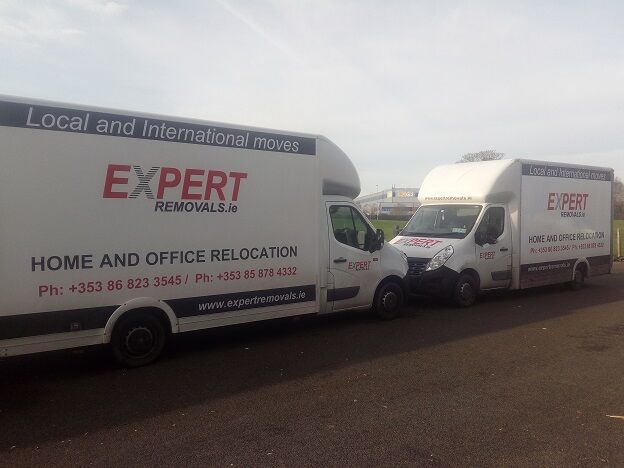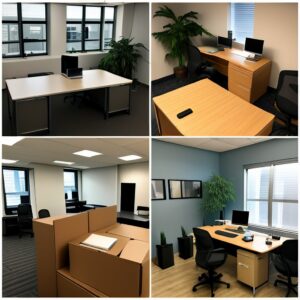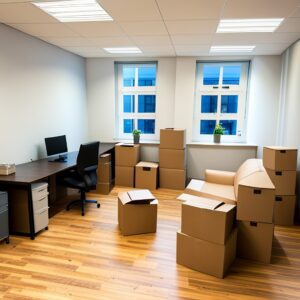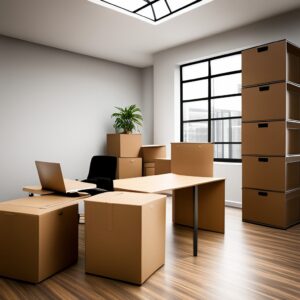Office Removals Dublin
Moving an office can be a daunting task, requiring careful planning and coordination. Office removals involve the transportation of valuable equipment, furniture, documents, and technology, which are essential for the smooth operation of a business.
Efficient office removals are crucial to ensure minimal disruption to daily operations and to facilitate a seamless transition to a new location.
In this post, we will explore the importance of efficient office removals and the benefits of hiring professional office removal services.

Planning your office move
Determining the timeline and budget for the move
Planning is essential when it comes to office relocations, as it ensures a smooth and efficient transition. Here are some factors to consider in the planning process:
1. Timeline: Determine the ideal timeframe for your move, taking into account any lease agreements, potential disruptions to business operations, and the availability of moving services.
2. Budget: Set a budget for your office move, taking into account expenses such as packing materials, moving services, and any necessary renovations or repairs at the new location.
3. Hiring professional movers: Consider hiring professional office movers who specialize in commercial relocations. They have the expertise and equipment to handle the logistics of moving office furniture, equipment, and sensitive documents.
4. Communicating with employees: Keep your employees informed about the office move, including the timeline and any changes to their workspaces or routines. Clear communication ensures a smooth transition and minimizes disruption.
Evaluating your current office space and identifying needs for the new location
Before making the move, it’s important to evaluate your current office space and identify the needs and requirements for the new location. Here are some points to consider:
1. Layout and functionality: Assess the current office layout and identify any limitations or areas that can be improved in the new space. Consider factors such as open workspace areas, private offices, meeting rooms, and break areas.
2. Size and capacity: Determine the square footage required for your office operations, taking into account the number of employees, furniture, equipment, and storage needs. Ensure that the new location can accommodate future growth and expansion.
3. Accessibility and amenities: Evaluate the accessibility of the current office space and consider the amenities that are crucial for your business and employees, such as parking, public transportation, and nearby amenities like restaurants and shops.
4. Infrastructure and technology: Assess the current infrastructure and technology setup in your office and identify any upgrades or improvements needed for the new location. Consider factors such as internet connectivity, phone systems, and IT infrastructure.

Finding a reliable office removal company
When it comes to office removals in Dublin, finding a reliable and professional company is key to ensuring a smooth and efficient transition.
Here are some steps to help you find the right office removal company for your business:
Researching and comparing office removal companies in Dublin
- Start by conducting thorough research on office removal companies in Dublin. Look for companies that specialize in office relocations and have experience in handling similar projects.
- Take note of the services offered by each company. Do they provide packing and unpacking services, furniture disassembly and reassembly, or storage options? Consider the specific needs of your office move and choose a company that can meet those requirements.
- Compare pricing and request quotes from multiple companies. While it’s important to consider cost, remember that quality and reliability are equally important factors to consider.
Reading reviews and checking credentials
- Read online reviews and testimonials from previous customers. These can provide insights into the company’s professionalism, communication, and efficiency during the moving process.
- Check the credentials and certifications of the office removal company. Make sure they have the necessary licenses and insurance coverage to protect your items during the move.
- Consider asking for references from the company and contact previous clients to hear about their experiences.
Preparing for the office move
Creating a detailed inventory of all office items and equipment
Before the office move, it is essential to create a detailed inventory of all office items and equipment.
This will help ensure that nothing is misplaced or lost during the transition. Some key steps to follow include:
- Take stock of all furniture, electronics, and other office equipment. Make a list of everything that needs to be moved to the new location.
- Label each item with a unique identifier or tag to make it easy to track during the move.
- Consider taking photos or videos of each item to serve as documentation and aid in the set-up at the new office.
- Consult with the moving company to ensure that they have a clear understanding of the inventory and any special requirements for handling specific items.
Organizing paperwork and files for a smooth transition
In addition to physical items, it is crucial to organize paperwork and files for a smooth transition. Here are some tips to help with this process:
- Sort through all documents and files and determine what needs to be kept, what can be discarded, and what needs to be moved to the new office.
- Consider digitizing important documents to reduce the amount of physical paperwork that needs to be moved.
- Develop a filing system for the new office that is organized, efficient, and easy to navigate.
- Notify clients, suppliers, and other stakeholders of the upcoming move and provide them with any necessary updates or contact information.
Packing and labeling
When it comes to office removals Dublin, efficient packing and labeling are key to a smooth and organized move.
Here are some tips to help you pack and label your office items efficiently:
Tips for efficient packing and labeling of office items
Start by decluttering: Before you start packing, go through your office and get rid of any unnecessary items. This will not only make packing easier but also save you time and money on transportation.
Categorize items: Sort your office items into categories such as electronics, documents, office supplies, and furniture. This will make it easier to pack and unpack at your new location.
Use proper packing materials: Invest in high-quality packing materials such as sturdy boxes, bubble wrap, packing tape, and labeling stickers. This will help protect your items during transit.
Label boxes clearly: Label each box with its contents and the room it belongs to. This will make it easier to unpack and set up your new office. You can also use color-coded labels to identify specific departments or areas.
Take inventory: Make a detailed inventory of all your office items and their condition before the move. This will help ensure that nothing gets lost or damaged during transportation.
Ensuring the safety of delicate equipment during transportation
Wrap fragile items securely: Use bubble wrap or packing paper to wrap delicate equipment such as computers, monitors, and printers. Place them in sturdy boxes, filling any empty spaces with packing materials to prevent movement.
Use proper packing techniques: When packing fragile items, use the “double box” technique. Place the wrapped equipment in a smaller box and then pack it inside a larger box with cushioning material in between. This will provide extra protection during transit.
Mark fragile items: Clearly mark boxes that contain delicate equipment as “Fragile” to alert movers and ensure they handle them with care.
Consider professional packing services: If you have valuable or highly sensitive equipment, it may be worth hiring professional packers who specialize in office removals. They will have the expertise and experience to pack and transport delicate items safely.
Furniture disassembly and assembly
Proper disassembly and reassembly of office furniture
When it comes to office removals, one of the most challenging tasks is handling and transporting office furniture.
Office furniture can be large, heavy, and complex to disassemble and reassemble.
It requires precision and expertise to ensure that the furniture is properly taken apart and put back together without any damage. This is where professional office removals services come in handy.
They have the knowledge and experience to safely disassemble and reassemble all types of office furniture, including desks, chairs, conference tables, and cabinets.
By hiring professionals for furniture disassembly and assembly, you can:
Save time and effort: Disassembling and reassembling office furniture can be a time-consuming process. By delegating this task to professionals, you can focus on other important aspects of your office move.
Ensure proper handling: Professionals have the necessary tools and techniques to handle office furniture safely. They will take the necessary precautions to prevent any damage during the disassembly and assembly process.
Reduce the risk of damage: Improper handling of office furniture can lead to scratches, dents, and other damages. Professionals know how to handle each piece of furniture properly, ensuring that it is disassembled and reassembled without any damage.
Hiring professionals for furniture handling and installation
When it comes to office removals, hiring professionals for furniture handling and installation is essential.
These professionals have the expertise to handle all types of office furniture, ensuring that it is properly transported, assembled, and installed in your new office space.
Here are some reasons why it is important to hire professionals for furniture handling and installation:
Expertise: Professionals have the knowledge and experience to handle furniture of all shapes and sizes. They are trained in proper lifting and carrying techniques, ensuring that your furniture is handled safely and efficiently.
Equipment: Professionals have the necessary equipment to move and install furniture properly. This includes tools for disassembly and reassembly, as well as equipment for lifting and moving heavy furniture.
Efficiency: Hiring professionals can help streamline the office removals process. They have the expertise to quickly and efficiently handle and install furniture, minimizing downtime and disruptions to your business operations.
Safety: Professionals prioritize safety during furniture handling and installation. They take the necessary precautions to prevent injuries and accidents, ensuring a safe working environment for everyone involved.
IT infrastructure and equipment
Safely disconnecting and reconnecting computers, servers, and other tech equipment
When it comes to office removals in Dublin, one of the crucial aspects is ensuring that your IT infrastructure and equipment are safely disconnected and reconnected during the move.
This is essential to minimize downtime and ensure that your business operations can resume smoothly in the new location.
Here are some key steps involved in safely handling your IT equipment during an office move:
Create a detailed inventory: Before the move, create a comprehensive inventory of all your IT equipment, including computers, servers, printers, and other tech devices. This will help you keep track of all your equipment during the move.
Backup important data: Prior to disconnecting any equipment, it is vital to back up all important data and files. This will ensure that no data is lost during the move, safeguarding your business’s important information.
Properly pack and label equipment: Use appropriate packing materials and boxes to pack your IT equipment carefully. Label each box clearly to indicate its contents and the room it belongs to. This will make unpacking and reconnecting much more efficient.
Coordinate with your IT team or hire professionals: If you have an internal IT team, ensure they are involved in the moving process and coordinate with them to handle the disconnection and reconnection of your IT equipment. Alternatively, you can hire professional IT movers who specialize in handling and transporting sensitive tech equipment.
Securely transport equipment: During the move, it is crucial to ensure that your IT equipment is securely transported to avoid any damage. Use padded transportation crates or special containers designed to protect fragile electronics.
Set up the new IT infrastructure: Once the equipment has been safely transported to the new location, work with your IT team or professionals to set up the new IT infrastructure. This includes reconnecting computers, servers, and other devices, as well as configuring the network and ensuring that everything is functioning correctly.
Test and troubleshoot: After the equipment has been reconnected, conduct thorough testing to ensure everything is functioning as expected. Address any connectivity or performance issues promptly to minimize downtime and disruptions to your business operations.
Office setup in the new location
Optimizing the layout and design of the new office space
Once you have successfully relocated your office to a new location in Dublin, it’s time to set up your new workspace to maximize efficiency and productivity.
Here are some key steps to consider:
1. Space Planning: Assess the layout and dimensions of the new office space and determine the most efficient way to arrange workstations, meeting rooms, and common areas. Consider factors such as natural light, accessibility, and workflow.
2. Ergonomic Design: Ensure that workstations are ergonomically designed to promote employee comfort and reduce the risk of injuries. Invest in adjustable desks, ergonomic chairs, and proper lighting to create a healthy and comfortable work environment.
3. Collaboration Spaces: Create designated areas for collaboration and brainstorming sessions. This can include breakout rooms, communal areas, and open-plan spaces to encourage communication and teamwork among employees.
Setting up workstations, meeting rooms, and common areas
1. Workstations: Set up individual workstations with desks, chairs, and necessary equipment such as computers, monitors, and telephones. Ensure that each workstation has access to power outlets and sufficient storage space.
2. Meeting Rooms: Install conference tables, chairs, and audiovisual equipment in meeting rooms to facilitate productive meetings and presentations. Consider adding whiteboards or digital displays for visual aids.
3. Common Areas: Create comfortable and inviting common areas where employees can take breaks, socialize, and recharge. This can include lounge areas, kitchenettes, and recreational spaces with amenities such as coffee machines, microwaves, and refrigerators.
Take the time to carefully plan and set up your new office space to create a functional and inspiring work environment for your employees. This will help boost morale, productivity, and overall satisfaction.
Communication and employee engagement during the office move
Keeping employees informed and engaged throughout the moving process
During an office move, effective communication and employee engagement are crucial to ensure a smooth transition and minimize disruption to daily operations. Here are some strategies to keep employees informed and engaged throughout the moving process:
1. Communication Plan: Develop a comprehensive communication plan that outlines the timeline, key milestones, and expectations for employees during the move. This plan should include regular email updates, town hall meetings, and a designated point of contact for employees to ask questions or raise concerns.
2. Town Hall Meetings: Schedule regular town hall meetings to provide updates on the move and address any employee concerns. These meetings are an opportunity to provide important information, gather feedback, and create a sense of unity and transparency.
3. Employee Surveys: Conduct regular employee surveys to gauge their opinions and concerns throughout the moving process. Encourage open and honest feedback, and use the survey results to address any issues or improve the move experience for employees.
4. Training and Support: Provide training and support to employees to ensure a smooth transition to the new office space. This can include training on new technologies or systems, as well as assistance with packing and unpacking personal belongings.
5. Team-Building Activities: Organize team-building activities and social events before, during, and after the move to foster a sense of camaraderie among employees. These activities can help alleviate stress and build positive relationships during this transitional period.
6. Inclusion and Collaboration: Involve employees in the decision-making process whenever possible. Seek their input on office layout, design, and amenities to create a space that meets their needs and preferences. This sense of ownership can increase employee engagement and satisfaction.
7. Celebrate Milestones: Recognize and celebrate key milestones throughout the moving process, such as the completion of packing or the successful relocation of departments. This creates a sense of accomplishment and motivates employees to stay engaged and positive throughout the move.
Post-move evaluation and adjustments
Assessing the success of the office move and making necessary adjustments
Once the office move is complete, it’s important to take the time to evaluate its success and make any necessary adjustments.
This allows you to ensure that your business is running smoothly in its new location and address any issues that may have arisen during the move.
Here are some steps you can take:
- Conduct a post-move meeting with key stakeholders to discuss the overall success of the move and address any concerns or challenges that may have come up.
- Evaluate the functionality of the new office layout and design. Are there any areas that need improvement or reconfiguration? Are employees comfortable and productive in their new workspaces?
- Assess the effectiveness of the moving process. Did everything go according to plan? Were there any delays or complications? Identify any areas for improvement in future moves.
- Evaluate the performance of the moving company or team that handled the relocation. Were they professional and efficient? Did they handle any fragile or valuable items with care?
- Consider feedback from employees about their experience with the move. Were their needs and concerns adequately addressed? Take their input into account when making adjustments.
Addressing any issues or challenges that arise
During the post-move evaluation, it’s important to identify and address any issues or challenges that may have arisen during the relocation process. This includes:
- Resolving any technical or connectivity issues. If there are problems with the office’s IT infrastructure, internet connection, or phone systems, contact the appropriate vendors or service providers to have them resolved as quickly as possible.
- Communicating any changes or updates to clients, customers, or business partners. If there were any changes to your address, contact information, or operating hours, make sure to inform all relevant parties to avoid any confusion or disruptions.
- Providing support and resources to employees who may be struggling to adjust to the new office environment. Offer training or assistance with any new technologies or procedures, and encourage open communication to address any concerns or challenges.
- Making necessary adjustments to the office layout, furniture, or equipment based on feedback from employees or the post-move evaluation. This may include repositioning workstations, adding additional storage, or making changes to the lighting or temperature control.

Office Removals Dublin
Benefits of hiring professional office removal services for a successful move
When it comes to moving your office, hiring professional office removal services can make a significant difference. Here are some of the benefits:
1. Expertise and Experience: Professional office removal services have the expertise and experience needed to handle all aspects of the move efficiently. They have trained professionals who understand how to pack and transport office equipment, ensuring its safety throughout the process.
2. Time and Cost Savings: Hiring professionals allows you to save time and money by avoiding the need to allocate your employees to the moving process. The professionals will take care of everything, allowing your employees to focus on their work, resulting in minimal disruption to your business operations.
3. Proper Equipment and Materials: Office removal services have access to the right equipment and materials needed for a successful move. They understand the best packing techniques and use high-quality materials to protect your valuable office equipment and furniture during transport.
4. Insurance Coverage: Professional office removal services typically have insurance coverage, meaning that in the unlikely event of any damage or loss during the move, you will be protected. This can provide peace of mind and added security during the transition.
5. Streamlined Process: Office removal services have a streamlined process in place, ensuring that everything is organized and executed efficiently. They will plan the move, coordinate logistics, and handle any unforeseen challenges that may arise, allowing for a smooth and stress-free transition.
By hiring professional office removal services, you can ensure a successful move for your business, saving time, reducing costs, and minimizing disruptions to your operations.
It is worth considering this option to make your office relocation as seamless as possible.






